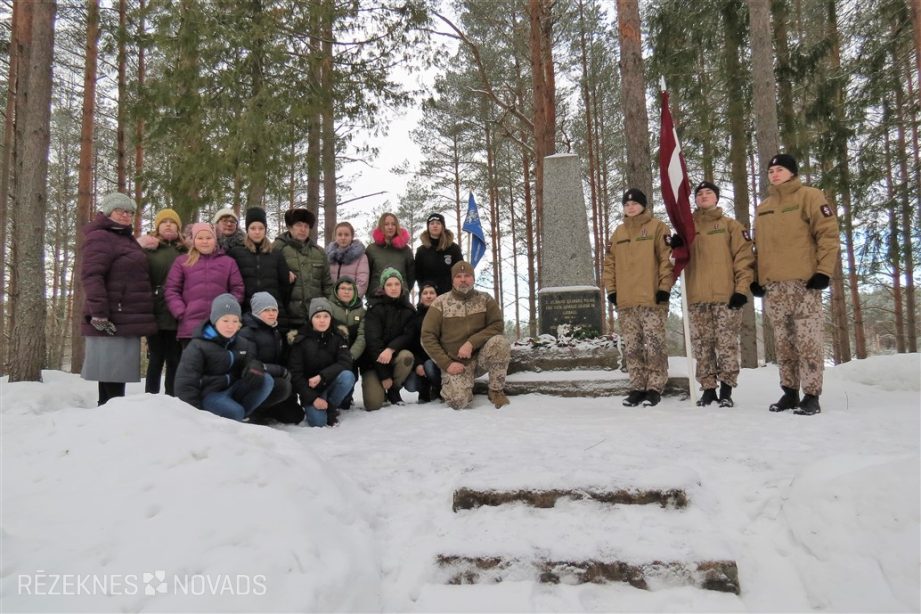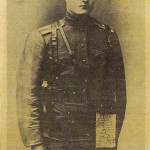IN the event organised BY THE Museum OF Maltas, young guards honour freedom fighters

On 18 January, Maltas museum employees together with 306. Maltas for young guards of young guards gathered in Rēzekne Municipality Feimaņu parish Rusenica at 3. The memorial obelisk of Jelgava's infantry regiment to mention the liberty fighters that had fallen over 99 years ago.
“This memorial place is particularly close to the newsguards.” For more than 20 years every spring, when snow is melted and every autumn when the trees have fallen leaves, Maltas, Dagda and Aglona are gathered here to clean up the surroundings, grabbed leaves and grass, harvesting the fallen trees. In this place, the solemn promise of a young man has also appeared. This year there is a joy in children's chalks because there is a change in the surroundings. There are wooden steps in which it is convenient to access the memorial site, the informative plate of the municipality of Rezekne is installed, which reports the harsh pages of history, ”says Ivars Kļaviņš, head of the newly-guards unit of Rezekne.
Sylvia Pigožne, head of THE museum OF Maltas, introduced the freedom struggles in Latgale and stressed: “This stage in Latvia's history is one of the most serious and also inspiring. Fighting against a numerically larger and better armed opponent, Latvian soldiers struggled with great excitement and heroism. Today with us is the son of an officer of Daugavgrîva Latvian riflemen, Anton Urtan, Joseph Urtan. Anton Urtan struggled in the Christmas battle where he was injured. He was, by the way, the leader of Evald Walter. 'She asked Joseph Urtan to share her memories and think about her father.
“Father Anton Urtan was taken by the army when he was 18 (at that time he was usually taken in the army when he had reached age 21). He had finished six classes. He took his place in Riga, but after three months he obtained the degree of“ podporuchics ”(Lieutenant). Sent to Tereshamv for a part of the war. It was in the autumn of 1916. He gave the pistol a“ colt. ”The war in the Army was very bad. The Army of the Tsar led mainly to the battle. The Germans were on the island of death and the Lower Mountain. By Christmas there was a lot of burnt battles, mostly shooting shots, and then a shooting artillery.
On 22 December, the new officers were talking about the expected battles, but for the time being, the gunners were asked not to say. The grenadiers gave the rifles and 7 cartridges, still magazines with 7 cartridges. There was a wish to take a position at Christmas. The grenadiers had to cut the barrel, destroy fencing and items. There was an order without an artillery to launch an attack. That was the tactics of the attack, the quiet.
His father was in the central attack line. The attack started on Christmas night. The first was successful, with small losses. When the first lines took place, the captives were not taken away, all destroyed. The bunks bombed with grenades. Part of the Germans resigned to lines 2. On the second morning, a Germans' contentment began. The Germans started with the artillery. They shot to Line 1 because they were already taken by Latvians. Latvians resigned. Disappeared with the artillery. The entire artillery is mapped to Line 1. He started shooting at his own. He ran away to announce that he had to stop shooting. On the third day, they were going to attack again. The battle was held from Christmas to January 10. The positions changed all the time. The last battle was wounded by his father from an artillery in his head and on both legs. In the battle he saw a horrible view as the soldier pulled his head off, but he still ran for 10 metres.
Around 10 January, the Germans are healed to Jelgau. The fallen was about 4000. Because there was no place in Riga hospitals, the wounded was taken by a sanitary train to St. Petersburg hospital. His father wrote a letter to the caram to run him to Latvia. Said. He was treated until autumn. Some soldiers were taken to protect Lenin. He also wrote for redfish. They also rejected. After the October revolution, the civil war began. The Civil War took up the younger officers. The cheselon went to Poland. His father had a card as an officer. Along with 4 nearby members, they decided to escape from the red army. He went through the night, but he was lying in the day. The Polish civilians were afraid to admit. His father knew the Polish language when he knew it, gave i bread, i meat.
The Brest-Litovsk peace treaty had already been concluded. Refugees came to the border of Latvia. He made a twig cabin. They fell asleep from fatigue. They were found by Latvian border guards. When they slept, some had been stolen, so they put them in the hospital. The father was rehabilitated: all weapons and titles were preserved. He became a reserve officer. He came to his mother, then joined the pedagogical school. After school, she worked as a master at the School of Basic School. Anton's father tumbled the flax. In 1922 he bought land in Russia and border. Bought a third part of Babra Manor Pušā. In 1935, Anton Urtan came to work on the Doropolol School, but he came to the Pušas school after a war in 1949. There was also a list for sending. Mr Lukiansky, President of the village, struck him out. Eternity left in 1983. (The son of the son Joseph Urtan was signed by Sylvia Pigojne 22.01.2019)

Photo: Officer Anton Urtan (1897-1983)
***
From history pages.
In the history of Latvia, one of the most important events was the war of liberation of liberty or the release of Latvia. They were fighting for an independent Latvian state from its proclamation on 18 November 1918 until the conclusion of the Latvian-Russian Peace Agreement on 11 August 1920. After victory over Colonel Paul Bermont-Avalova's commanded troops in November 1919, most of Latvia's territory was released. Only Latgale was still in control. In December 1919, the military headquarters of the Latvian Army began planning the Latgale release operation. On January 1, 1920, the Latvian Army units took positions in Latgale.
The parish area of Rozentova was in the hands of the Bolshevik Army since the end of 1917. In early 1920, THE MILITARY operations of THE LR Army, the Polish Army and the Cape Baltians were started with the aim of taking Rēzekne. On 17 January, the Landesman made a rapid attack on Antonopole Station. After an angry battle with the guns, he took a station where he got 21 wagons, 32 lavums, field kitchens, cigarettes and other war items. That same day, the right wing of the lande took Rosentova's manor. Perhaps the house of Rosentova Manor was devastated during these battles.
18 January 9. The left wing of the Rēzekne militia, aligning with the landeship positions, rose to the rail south of Antonopole. Landesworth did not go ahead, but he did his intelligence. The armed train No. 3 repaired the railway bridge in the Antonopole district. On 20 January, the Rēzekne regiment was sent to Antonopoli 3. A battalion of the Jelgava infantry regiment. As a result of concerted action, Rēzekne and the entire central Latgale were taken over on 21 January.
For Latgale Battle General Peter Radzinš wrote: “The importance of the Latgale release war is very large; i think that the victory in Latgale has a greater role than the victory against Bermont. In the war against Bermont, we took a war against the enemy without an idea, without Father; the enemy was also tried to combat the Allies and helped us most as moral, its materials. Latgale's liberation in the war did not help us anymore. Our troops had both the national sensation and the hatred of red terror, but on the other hand, our troops and the people were propaganda in favour of this red terror. Our troops had to deal with a very large enemy, a great country-enemy who had won all the white Russian army. With this victory, we proved to the whole world that we have a fully defined nationalist consciousness that does not give any protrusions either to the right or to the left. Only with this victory we got the eastern border of Latvia. If we had not warned and won Soviet Russian troops, we would not only ever join Latgale with Latvia, but we would never have also gained peace and security from the Russian side. In 1920, the Latvian Army declared the final merger and independence of Latvia. '
(Silvia Pigojne was prepared. Sources of information: Maltas civil parish studies and memory// A. Part 1, Chapter 5 – Malta, 2018, p. 60; History of the Liberation of Latvia. Sēj 2 – R., 1938; Juris Ciganov. Latvian Independence War. 1918. -1920.)
Intas Danovsk photo